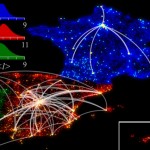 During the Brexit debate there has been much discussion around the potential for Britain to trade with the world. Critics base their argument around research highlighting the importance of physical proximity in trade, which they suggest underlines why much of British trade is with European nations that are nearby rather than Commonwealth nations, which are not.
During the Brexit debate there has been much discussion around the potential for Britain to trade with the world. Critics base their argument around research highlighting the importance of physical proximity in trade, which they suggest underlines why much of British trade is with European nations that are nearby rather than Commonwealth nations, which are not.
That this trend has persisted despite the emergence of digital technologies that should flatten distances is interesting, and a recent study by San Diego State University highlights that it applies just as much on a micro scale as it does on a macro scale.
The study was a 16-month effort that saw over 51 million geo-tagged tweets analyzed from over 1.7 million users all over the United States between November 2015 and January 2016. None of the data collected was identifiable, and the researchers aimed to try and identify any connections between online and real world interactions between users in four cities: Chicago, Houston, LA and New York.
Mapping interactions
These interactions would include a range of things, including trips, telephone conversations and emails, with the ultimate goal of identifying connections between places.
“When we are analyzing social media, or big data, while also handling the geospatial information, we can more precisely analyze data from a regional perspective,” the researchers explain.
The study sought to examine three main issues:
- How people follow one another
- The awareness we have of the location of our followers
- Whether we travel to the cities our followers live in
Interestingly, it emerged that roughly 90% of people’s tweets were made from their home city during the 16 month study period. Their followers however tend to be much more dispersed, but the user themselves was largely oblivious to the location of their followers.
Perhaps understandably, few people had real world interactions with followers if they were a couple of hours travel away, with the vast majority of such interactions confined to people who lived nearby.
“We know that people are communicating much more frequently with nearby people than those who are far away,” the researchers say. “Even in cyberspace, the same thing is very likely to happen because, in many cases, people get to know each other in real space and also communicate with the same people online.”
The only exception to this general rule was Los Angeles, where users would interact with people over a much wider area, with fewer real life interactions with followers in the same immediate vicinity. The team believe that the entertainment industry prevalent in the city perhaps distorts the trend somewhat.
The researchers believe that their findings can prove useful in identifying and addressing a range of social issues and concerns.
“If you are a public health official who wants to spread information about disease prevention, you will be interested in looking at how far and quickly the information spread among people through social media,” they conclude. “Also, if you are a political campaigner who wants to spread an election pledge through social media, you will want to see how far and quickly the information spread through people in the social media.”